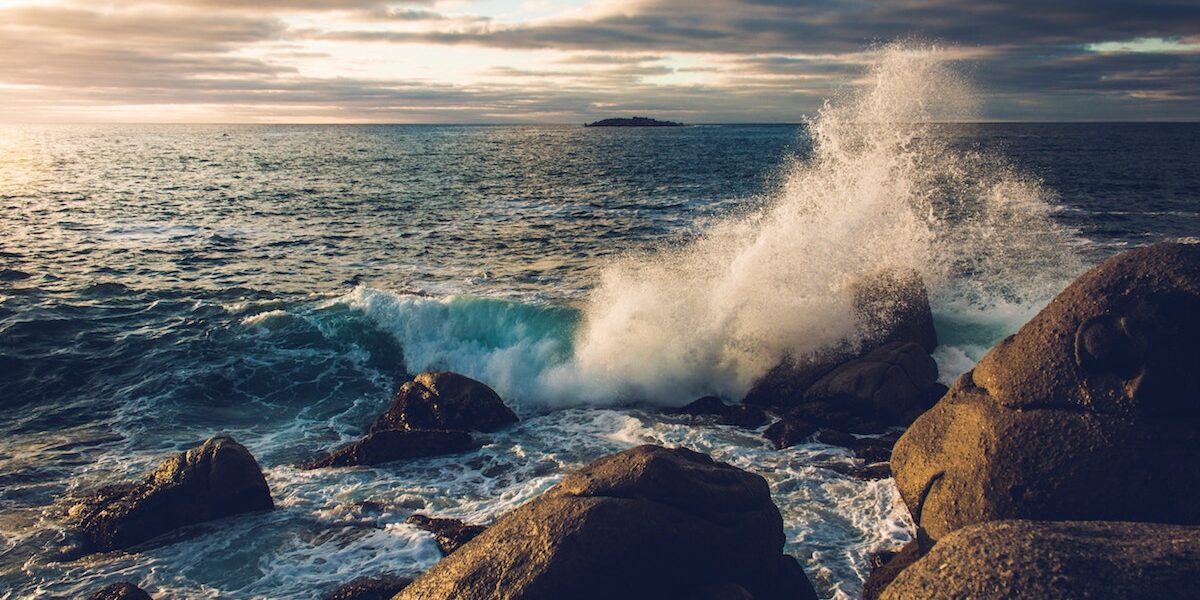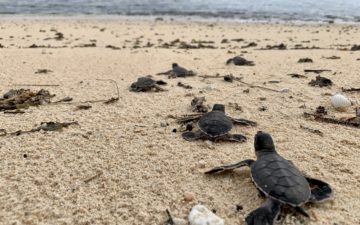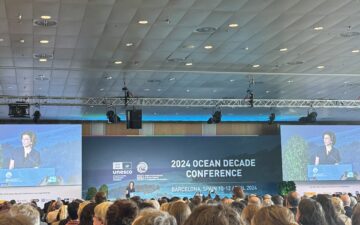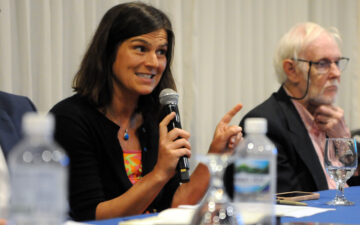by Mark J. Spalding
The Ocean Foundation is the first “community foundation” for the oceans, with all the well-established tools of a community foundation and a unique focus on marine conservation. As such, The Ocean Foundation addresses two major obstacles to more effective marine conservation: a shortage of money and the lack of a venue in which to readily connect marine conservation experts to donors who wish to invest. Our mission is to support, strengthen, and promote those organizations dedicated to reversing the trend of destruction of ocean environments around the world.
3rd Quarter 2005 Investments by The Ocean Foundation
During the 3rd Quarter of 2005, The Ocean Foundation highlighted the following projects, and made grants to support them:
| Title | Grantee | Amount |
|
Coral Field of Interest Fund Grants |
|
|
| Coral reef conservation efforts in Mexico | Centro Ukana I Akumal |
$2,500.00 |
| Education on coral reef conservation around the world | RARE |
$1,000.00 |
| Coral reef conservation efforts (red tide monitoring in the Gulf) | REEF |
$1,000.00 |
|
Project Support Grants |
|
|
| Ocean conservation advocacy (at the national level) | Ocean Champions (c4) |
$19,500.00 |
|
Staff Recommended Grants |
|
|
| NOAA Education Program promotion project of the Campaign for Environmental Literacy | Public Interest Projects |
$5,000.00 |
| Channel Islands Sanctuary Dinner | National Marine Sanctuary Fdn |
$2,500.00 |
| Coverage of ocean environmental related issues | Grist Magazine |
$1,000.00 |
| 30th anniversary of the Monitor National Marine Sanctuary dinner | National Marine Sanctuary Fdn |
$5,000.00 |
HURRICANES AND MARINE CONSERVATION
FISHERIES
Dozens of shrimp trawlers, their cranes and netting splaying from their sides like wings, have been tossed ashore or into sea grass. They lay clumped or alone at awkward angles . . . shrimp processing plants on the bayou are smashed up and smeared with awful-smelling mud slime, inches thick. The water has receded, but the whole area smells like sewage, diesel fuel and decay. (IntraFish Media, 7 September 2005)
Almost 30% of the fish consumed in the US each year comes from the Gulf of Mexico, and half of all oysters consumed are from Louisiana waters. Hurricanes Katrina and Rita caused an estimated $2 billion in seafood industry losses, and this amount does not include damaged infrastructure, such as boats, docks, and plants. As a result, the National Oceanic and Atmospheric Administration (NOAA) has declared a fisheries disaster in the Gulf, a necessary step to free up aid to fishermen and local fish and wildlife agencies.
Species such brown and white shrimp that spawn offshore and move inland to live in marshes have had much of their habitat destroyed. Fish and wildlife officials have also expressed concern that there will be an increase in fish kills as a result of “dead zones,” areas of little or no oxygen as decaying organic matter that has washed into lakes and the Gulf.
An estimated half to three-quarters of the lobster-trapping industry in Florida has been wiped out from damage to equipment. Florida’s Franklin County oyster industry, already struggling with damage caused by Hurricane Dennis, is now battling a new wave of red tide and the destructive effects of Hurricane Katrina.
Also affected was the significant recreational fishing industry in Louisiana and other Gulf states. In Louisiana, sport fishing generated $895 million in retail sales in 2004, and supported 17,000 jobs (Associated Press, 10/4/05).
Anecdotal evidence from sharp declines in fisheries catches in the days before Hurricane Katrina indicate that many target species left the region ahead of the storm. While this gives many fishermen hope that the fish and fishing will one day return, it will be some time before we know when, or how healthy it will be.
POLLUTION
The estimates of damage to the fishing industry do not begin to account for any potential harm from the polluted water being pumped from New Orleans into Lake Ponchartrain and thence into the Gulf. Included in these concerns are the impacts of siltation and toxics on the $300 million a year oyster industry in Louisiana. Also of concern are the millions of gallons of oil that spilled during the storms—cleanup workers have reportedly already siphoned or removed 2.5 millions of gallons of oil from marshes, canals, and lands where the biggest spills occurred.
Obviously hurricanes have been hitting the Gulf coast for centuries. The trouble is the Gulf is now so heavily industrialized that this creates a secondary disaster for people and the ecosystems in the region. Numerous petrochemical plants, toxic waste sites, oil refineries and other industries are located along the Gulf and its tributaries. Government officials involved in the clean-up are still working to identify the “orphan” drums that, knocked loose and emptied by the storms have also lost their labels in the flooding following the recent storms. It is still unclear just what chemical spills, sewer overflows or other poisons washed into the Gulf of Mexico or the remaining coastal wetlands, or the extent of the debris taken back out into the Gulf with the receding of the storm surge. It is going to take months to clear away debris that will snag fishing nets and other gear. Heavy metals in the “toxic soup” from Katrina and Rita may have a long-term impact on coastal and pelagic fish populations, resulting in additional threat to the livelihood of the region’s commercial and sport fishermen, as well as the marine ecosystem.
A PORTENT OF WORSE TO COME
While it is impossible to say any one storm is caused by climate change, global warming very probably causes the growing frequency and ferocity of hurricanes hitting the United States. In addition, the October 3rd issue of Time magazine reported the increase in powerful hurricanes over the past two decades.
- Annual average of category 4 or 5 hurricanes 1970-1990: 10
- Annual average of category 4 or 5 hurricanes 1990-present: 18
- Average sea temperature increase in Gulf since 1970: 1 degree F
What these hurricanes represent, however, is the need for a focus on disaster preparedness, or rapid response for coasts and the organizations that work to protect their marine resources. We know that the world’s population is migrating to the coasts, that population growth will not level off for a few more decades, and that climate change predictions call for increased intensity (at the very least), and possibly the frequency, of these kinds of storms. The earlier hurricane season, and increased number and strength of hurricanes these last two years seem to be the precursors of what we face in the near future. In addition, the projected sea level rise could increase coastal vulnerability to storms because levees and other flood protection measures would be swamped more easily. Thus, Katrina and Rita could be the first of many urban coastal community disasters we can expect—with very serious ramifications for coastal marine resources.
The Ocean Foundation will continue to fund resilience, offer help where we can, and will seek opportunities to support the efforts of coastal conservation organizations and government agencies to ensure that good decision-making goes into rebuilding and restoration plans.
New Investment Opportunities
TOF closely monitors the forefront of ocean conservation work, searching for breakthrough solutions in need of funding and support, and communicating the most important new information to you.
Who: Wildlife Conservation Society
Where: U.S. waters/ Gulf of Mexico
What: The 42-square-nautical-mile Flower Garden Banks National Marine Sanctuary is one of only 13 sanctuaries legally designated to date, and is located in the Gulf of Mexico, about 110 miles off the coasts of Texas and Louisiana. The FGBNMS harbors one of the healthiest coral reef communities in the Caribbean region, and the northernmost coral reefs in the United States. It is home to healthy populations of commercially and economically important fish, including two giants: the largest fish and globally vulnerable whale shark and the largest ray, the manta. Scuba diving within FGBNMS supports the local economy and relies on an abundance of ocean wildlife for encounters with whale sharks, manta rays, and other large pelagic animals. Large marine highly migratory fish such as the Manta and Whale Shark are often the species that slip through the conservation cracks due to the lack of information on their biology and in particular the location and use of critical habitats, abundance and movements.
Why: Wildlife Conservation Society’s Dr. Rachel Graham has worked on a number of monitoring programs tagging and researching whale sharks in the Caribbean since 1998. The WCS project in the Gulf would be the first to study whale sharks in FGBNMS and their hypothesized migration between the Caribbean and the Gulf of Mexico. Information derived from this research is important due to the lack of information about these species in general and their diet and seasonal dependence on these seamounts as well as the importance of this national marine sanctuary in protecting them at different stages in their life-cycles. Whale shark meat is highly priced and the hunting of this peaceful giant jeopardizes the opportunity to learn more about them and their impact on their surrounding environment.
How: The Ocean Foundation’s Coral Reef Field-of-Interest Fund, which supports local projects that promote sustainable management of coral reefs and the species that depend on them, while seeking out opportunities to improve management for coral reefs on a much bigger scale.
Who: The Reef Environmental Education Foundation
Where: The Gulf of Mexico
What: REEF is working on ongoing fish surveying to document fish community structure and monitor fish in the Flower Garden Banks National Marine Sanctuary and Stetson Bank and will have the opportunity to do follow-up assessments comparing fish survey data from before and after the hurricanes. Located just miles from the Texas coast, the Flower Garden Banks National Marine Sanctuary (FGBNMS) serves as a biological reservoir of Caribbean species in the northern Gulf of Mexico and will serve as a bellwether of the health of reef fish in the Gulf in the wake of the storms. Temperatures are a few degrees cooler in winter at Stetson Bank, which is 48 km north and was added to the Sanctuary in 1996. The bank supports an extraordinary fish community. Recreational scuba diving and fishing are common activities within the sanctuary. Some parts of the sanctuary are grandfathered in for oil and gas production.
Why: REEF has been conducting fish surveys in the Gulf since 1994. The monitoring system in place allows REEF to track any changes to fish population, size, health, habitats and behavior. In the wake of Hurricanes passing through the Gulf region and the changes in warmer water temperatures, it is of great importance to find out how these climactic changes impact marine ecosystems. REEF’s experience and existing records of this region’s underwater environment will play a vital role in assessing the impacts of these recent hurricanes. REEF uses the surveys conducted to assist the Sanctuary in management processes and alerting the authorities of any threats to these habitats.
How: The Ocean Foundation’s Coral Reef Field-of-Interest Fund, which supports local projects that promote sustainable management of coral reefs and the species that depend on them, while seeking out opportunities to improve management for coral reefs on a much bigger scale.
Who: TOF Rapid Response Field-of-Interest Fund
Where: Internationally
What: This TOF fund will be an opportunity to offer financial support to organizations seeking immediate assistance for pressing needs and emergency work.
Why: In the wake of Hurricanes Emily, Katrina, Rita, and Stan as well as the Tsunami, TOF received urgent grant requests from a variety of organizations asking for funding to meet immediate needs. Those needs included funds for water quality monitoring equipment and laboratory testing fees; funds for replacing flood-damaged equipment; and funds for rapid assessment of marine resources to help inform a recovery/restoration response. There was also concern that the non-profit community lacks the ability to build the kind of reserves or purchase “business interruption insurance” that would help pay the salaries of their experienced, knowledgeable staff during these times of dislocation.
In the wake of those requests, the TOF Board decided to create a Fund that would solely be used to offer immediate assistance to groups dealing with emergency situations where resources are urgently needed. These situations are not limited to natural disasters, but would include projects that seek immediate effects even as efforts on a local level organize to create a long-term strategy for the affected marine resources and the livelihoods of those who depend on them.
How: Contributions from donors that specify they would like their money to be placed in the TOF Rapid Response FIF.
TOF News
- The Tiffany Foundation awarded TOF a $100,000 grant to support TOF staff in researching exciting projects around the world and assisting donors with the best opportunities for that fit their giving needs.
- TOF is in the process of its first professional audit and will have the report shortly!
- President Mark Spalding will be representing TOF at the Global Forum on Oceans, Coast, and Islands Conference on Global Policy in Lisbon, Portugal on October 10, 2005 where he will take part in an international donors roundtable.
- TOF recently completed two donor research reports: One on Isla del Coco, Costa Rica and the other on the Northwestern Hawaiian Islands.
- TOF helped sponsor a post-tsunami survey of impact on marine resources undertaken by the New England Aquarium and the National Geographic Society. The story will be in the December issue of National Geographic magazine.
Some Final Words
The Ocean Foundation is increasing the capacity of the ocean conservation field and bridging the gap between this time of growing awareness of the crisis in our oceans and true, implemented conservation of our oceans, including sustainable management and governance structures.
By 2008, TOF will have created an entirely new form of philanthropy (a cause-related community foundation), established the first international foundation focused solely on ocean conservation, and become the third largest private ocean conservation funder in the world. Any one of these achievements would justify the initial time and money to make TOF successful – all three make it a unique and compelling investment on behalf of the planet’s oceans and the billions of people who depend upon them for vital life support.
As with any foundation our costs of operation are for expenses that either directly support grantmaking activities or direct charitable activities (such as attending meetings of NGOs, funders, or participating on boards, etc.).
Because of the added necessity of scrupulous bookkeeping, donor cultivation, and other operational costs, we allocate about 8 to 10% as our administrative percentage. We expect a short term hike as we bring on new staff to anticipate our upcoming growth, but our overall goal will be to maintain these costs to a minimum, in keeping with our overarching vision of getting as much funding out to the field of marine conservation as possible.







